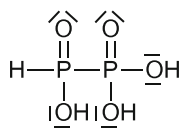Most of the online data banks such as PubChem don't bother with showing proper bond multiplicity since they are focused on searching for the compounds based on connectivity graphs. It doesn't mean that those are bad or unreliable, it's just not their primary focus.
The source of confusion here, I think, is terminology. Pyrophosphorous acid is an obsolete name for first member of the group of two isomeric diphosphonic acids (di- and tribasic) with $\ce{H4P2O5}$ formula featuring $\ce{P-O-P}$ and $\ce{P-P}$ bridges [1, p. 125; 2, p. 810]:
Diphosphonic(III,III) acid
Salts of diphosphonic(III,III) acid are obtained by heating of phosphonates $\ce{H2PO3-}$ to $\pu{150 °C}$ in vacuum:
$$\ce{2 H3PO4- → H2P2O5^2- + H2O}$$
The acid itself can be obtained from the barium salt by via treatment with sulfuric acid. A reaction between phosphonic acid and phosphorous trichloride also yields in diphosphonic acid provided that the hydrogen chloride formed is bound in order to shift the equilibrium:
Diphosphonic(II,IV) acid
Synthesized similarly to diphosphonic(III,III) acid from phosphonic acid by treating it with phoshorous tribromide or triiodite instead of trichloride. Another way is oxidation of diphosphoric(II,II) acid $\ce{H4P2O4}$ (aka hypodiphosphonic acid):
Notes
Illustrations for Lewis structures are adapted from Abb. 13.6 Sauerstoffsäuren des Phosphors [1, p. 125]. Syntheses and reaction schemes within are from Holleman's Lehrbuch der anorganischen Chemie [2, p. 810]; German text was translated and adapted by me (I tried to get it as close as possible, but no warranty).
References
- Kuhn, N.; Klapötke, T. M.; Walker, I. Allgemeine und anorganische Chemie: eine Einführung; Springer Spektrum: Berlin, 2014. ISBN 978-3-642-36866-0.
- Holleman, A. F.; Wiberg, E.; Wiberg, N. Lehrbuch der anorganischen Chemie, 102nd ed.; Fischer, G., Ed.; Walter de Gruyter: Berlin; New York, 2007. ISBN 978-3-11-017770-1.




